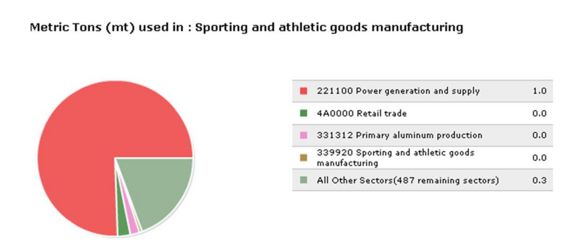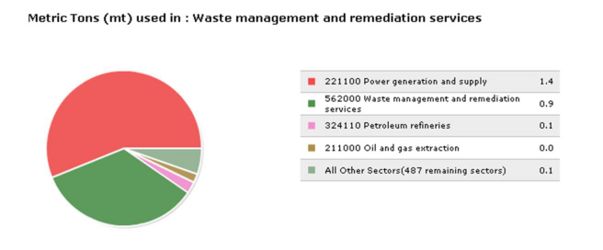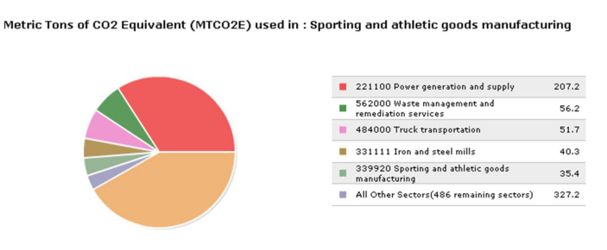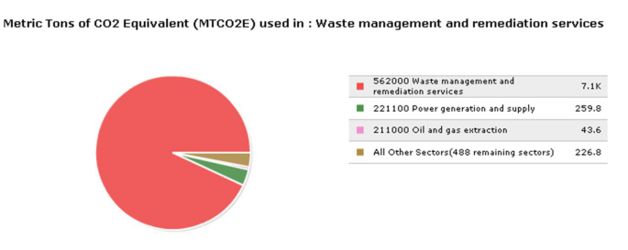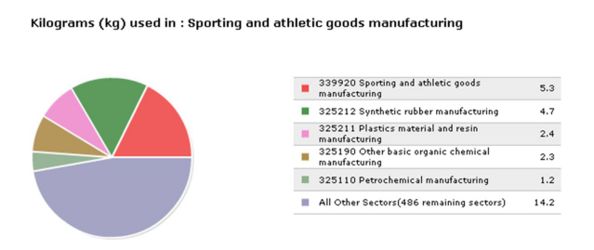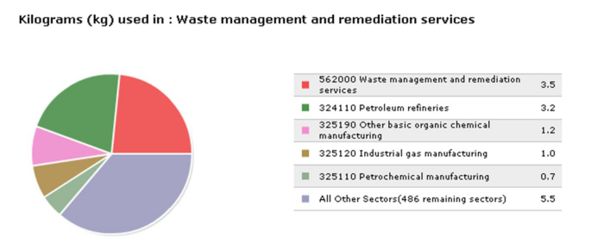Ski boot walking attachment
From DDL Wiki
(→Easy Production) |
(→Design for Environment(DFE)) |
||
| Line 42: | Line 42: | ||
===Design for Environment(DFE)=== | ===Design for Environment(DFE)=== | ||
| + | The design for environment analysis discusses how individual components of the walking attachment were designed in order to reduce the environmental impact of the product throughout its life-cycle. Design optimization of most products often puts more emphasis on DFM and DFA rather than on DFE, as reducing the time and cost of production would directly lead to greater profit. However, as environmental issues have come to draw more attentions from the public, the DFE analysis is becoming one of the significant aspects of product development that cannot be ignored. | ||
| + | |||
| + | Economic Input-Output Life Cycle Assessment (EIO-LCA) is often used as a common tool for conducting a DFE analysis on a product. EIO-LCA uses the following information as inputs - the product's purchase price and the most relevant sector to its manufacturing and end-usage. The EIO-LCA calculates how much environmental impact each of the manufacturing and the end-usage sectors creates from either producing or operating the amount of product(s) that is worth the input price of the simulation. The environmental impacts of the walking attachment calculated in this EIO-LCA include "Conventional Air Pollutants", "GHG Emission", and "Toxic Release". | ||
| + | |||
| + | Practically, a DFE analysis using EIO-LCA compares environmental impacts from the manufacturing sector and operational (end-usage) sector in order to assess which stage of the product's life cycle has the most significant impact on the environment. However, it is quite apparent that the walking attachment does not create any significant environmental impact during use since the product does not require any fuel to operate and is designed for long-term use (rather than being a quick, disposable product). Therefore, the environmental impact from end-usage of the walking attachment is said to be negligible. As a result, the main focus of this analysis is on the product's environmental impact during the manufacturing stage and its end of life (EOL) stage. The sectors associated with each of those stages are the "Sporting and athletic goods manufacturing" sector (manufacturing) and the "Waste management and remediation services" sector (EOL) respectively. The "US Department of Commerce 1997 Purchase Price Model" is used in all of the EIO-LCA presented in the following section since it is the most recently built model available that uses consumer purchase price as its input. The model makes estimation of "per-unit-product" environmental impacts easier as the market price of the product is known. | ||
| + | |||
| + | '''More emphasis on environment-friendly manufacturing methods''' | ||
| + | |||
| + | The detailed EIO-LCA results are summarized in the following section (Summaries and Specifics of EIO-LCA). | ||
| + | |||
| + | The simulation results show that manufacturing phase creates twice as much toxic release (30.1 kg/$1M) than disposal of the product does (15.1 kg/$1M). However, the relationship flips when discussing the amount of conventional pollutants emitted, as contributions from product disposal (2.5 metric tons/ $1M) nearly doubles that of manufacturing phase (1.3 metric tons/ $1M). What is more striking is that in terms of GHG emission, product disposal (7,600 MTCO2E/ $1M) has 10.5 times greater impact on the environment than the emission from the manufacturing sector (718 MTCO2E/ $1M). Thus, it is easy to conclude that in terms of environmental impact per cost, the most significant environmental impacts during the product's life cycle occurs in its post end-use (disposal) phase. | ||
| + | |||
| + | However, since the cost of manufacturing a unit of product and the cost of managing waste from a unit of product are not equal, environmental impact per unit of product (rather than per $1M economic input) needs to be determined. According to "THE PRICE OF SOLID WASTE MANAGEMENT SERVICES IN VERMONT" a study conducted by DSM Environmental Services, Inc. for the Vermont Department of Environmental Conservation (2005), managing 1 ton (1,000kg) of waste costs approximately $100. As the product analyzed in this DFE (WalkEZ) weighs about 1kg per unit, the waste management cost per unit is calculated to be around $0.10. The market price of the product is approximately $20 (200 times greater than the cost of waste management). Therefore, the simulated environmental impact per $1M from the EOL sector needs to be divided by a factor of 200 before being compared against the environmental impact per $1M from the manufacturing sector. | ||
| + | |||
| + | Combining those information, the manufacturing sector contributes approximately 0.602g of toxic release, 26.0g of conventional pollutants, and 0.0144 MTCO2E of GHG to the environment from producing one unit of the product. On the other hand, the EOL sector is responsible for 0.00151g of toxic release, 0.25g of conventional pollutants, and 0.00076MTCO2E of GHG per unit of product. Thus, it is apparent that the manufacturing sector is far more responsible for all the environmental impacts discussed here. | ||
| + | |||
| + | Major contributors to environmental impacts during the manufacturing phase | ||
| + | |||
| + | In manufacturing phase, power generation and supply are the biggest contributors to the sector's pollutants (77%) and GHG (29%) emissions. A more energy efficient manufacturing process would reduce those emissions. | ||
| + | |||
| + | |||
| + | More detailed results of EIO-LCA are summarized below. | ||
====EIO-LCA==== | ====EIO-LCA==== | ||
Revision as of 18:56, 9 December 2008
Contents |
Failure Mode and Effects Analysis (FMEA)
Design for X (DFX)
Design for X (DFX) analyzes a product to evaluate the efficiency of the product design from various perspectives. In this report, three major analyses are conducted on our final walking attachment design – Design for Manufacture (DFM), Design for Assembly (DFA), and Design for Environment (DFE). By conducting three types of DFX analyses, the overall efficiency of the product design during the manufacturing stage (DFM), assembly process (DFA), and post end-use impact to the environment (DFE) will be determined.
Design for Manufacture (DFM)
This design for manufacture analysis discusses how individual components of the walking attachment were designed in order to minimize the time and cost of the manufacturing process. The product design can be optimized for the manufacturing process through (1) reducing the number of components, (2) homogenizing the components, or (3) redesigning of the components. Reducing the number of components or homogenizing the components cuts the capital cost of production as fewer machines are required to manufacture the product. On the other hand, redesigning of the product aims to reduce the material cost per unit product by subtracting the unnecessary portions (dead weight) of the components from the original design. The following features of the final design contribute to the ease of manufacturing.
Symmetry
The walking attachment is identical for both the right and left boot. Because of this, the walking attachments can all be produced in the exact same way and they can simply be sold in pairs, without having to make sure there is one of each type in each pair. In addition to symmetry across the body, the walking attachment is, itself, symmetrical. If you cut the design down the middle from the front to back, it is a mirror image of itself. With this, the pieces of silicon and rubber on each side can be die stamped in the same way and that simplifies the manufacturing process.
Low Part Count
Because the final design contains very few parts, there are only a few manufacturing processes involved. We only need the rubber, silicon, and foam to be stamped, the entire top plate with toe piece can be made with two injection molding processes (one for the front and one for the rear), and the clip components, the links, and the folding rods can all be machined with relative ease. This is a pretty low number of manufacturing processes, and much of it can be done for a low price and in a small amount of time.
Easy Production
None of the processes listed above are incredibly time-consuming or costly and therefore manufacturing costs will remain relatively low. Each of the pieces production methods and advantages are listed below.
Top Plate
- The entire plate with toe piece can be made using injection molding allowing for a lightweight and robust design.
- Injection molding will waste little material and take a relatively low amount of time.
- Compared to other manufacturing processes, like machining, that could be used for this part, less material will be wasted, it will be faster, and at a higher production run, will cost less per unit.
Sole Components
- The sole components (the rubber, silicon, and foam) can all be die stamped.
- The production time will be very low.
- Although some material will be wasted, time saved and low input costs will keep the overall manufacturing costs low.
Clip Components
- The metal parts composing the clip can all be machined to specification with relative ease and little time.
- The metal pieces are all pretty simple, so machining will be easy and very few of them involve material removal.
- The plastic pieces on the clip can be made using injection molding.
- This allows for fast production and little material waste.
Design for Assembly (DFA)
A Design for Assembly analysis discusses how each component of the product was designed to minimize the time and cost of assembly. Efficient product design for assembly involves (1) simple configurations of the assembly and (2) ease of aligning the components. Simple configuration of the components prevents confusion and misplacement during the assembly process, while ease of aligning the components speeds up the assembly. The DFA on the main components of the walking attachment are provided below.
Sole
The sole is designed with a few pieces of rubber and foam embedded into two foam beds. All of these components are going to be die stamped, so the entirety of the assembly process will be arranging the pieces properly, and then gluing them together in the correct configuration. This must be done for the front and rear part of the sole. After these pieces are put together, the tread will be glued on to the bottom of the completed sole, and then the sole pieces themselves will be glued onto the front and rear top plates. Overall, the low number of parts and the simple arrangement were made for ease of assembly.
Top plate and Toe Piece
The top plate pieces themselves require no assembly since they each come as a single injection molded piece. In order to link the two halves together, the assembly worker must put the links in the appropriate slots, then slide the rods into the holes on the sides of the plate, and then simply cap the holes so the rod doesn't slide out. After that, the employee needs only to slide the rod through the rear plate, attach the clip to it, and then cap the ends. This linking design was made for very fast assembly because it only requires a few very easy steps.
Clip
The clip is by far the most complex part of the device for assembly. Although the assembly steps are somewhat difficult, there aren't that many parts so it doesn't take away from the overall low assembly time. The worker must take the large metal arc and rivet it to the connecting rod and then put the spring containment shell over the connecting rod. Once they put the spring inside, the cap needs to be attached to the end, and then the plastic clip itself needs to be screwed onto the metal arc. The clip is then completed and needs to be attached to the top plate to complete assembly of the device.
Design for Environment(DFE)
The design for environment analysis discusses how individual components of the walking attachment were designed in order to reduce the environmental impact of the product throughout its life-cycle. Design optimization of most products often puts more emphasis on DFM and DFA rather than on DFE, as reducing the time and cost of production would directly lead to greater profit. However, as environmental issues have come to draw more attentions from the public, the DFE analysis is becoming one of the significant aspects of product development that cannot be ignored.
Economic Input-Output Life Cycle Assessment (EIO-LCA) is often used as a common tool for conducting a DFE analysis on a product. EIO-LCA uses the following information as inputs - the product's purchase price and the most relevant sector to its manufacturing and end-usage. The EIO-LCA calculates how much environmental impact each of the manufacturing and the end-usage sectors creates from either producing or operating the amount of product(s) that is worth the input price of the simulation. The environmental impacts of the walking attachment calculated in this EIO-LCA include "Conventional Air Pollutants", "GHG Emission", and "Toxic Release".
Practically, a DFE analysis using EIO-LCA compares environmental impacts from the manufacturing sector and operational (end-usage) sector in order to assess which stage of the product's life cycle has the most significant impact on the environment. However, it is quite apparent that the walking attachment does not create any significant environmental impact during use since the product does not require any fuel to operate and is designed for long-term use (rather than being a quick, disposable product). Therefore, the environmental impact from end-usage of the walking attachment is said to be negligible. As a result, the main focus of this analysis is on the product's environmental impact during the manufacturing stage and its end of life (EOL) stage. The sectors associated with each of those stages are the "Sporting and athletic goods manufacturing" sector (manufacturing) and the "Waste management and remediation services" sector (EOL) respectively. The "US Department of Commerce 1997 Purchase Price Model" is used in all of the EIO-LCA presented in the following section since it is the most recently built model available that uses consumer purchase price as its input. The model makes estimation of "per-unit-product" environmental impacts easier as the market price of the product is known.
More emphasis on environment-friendly manufacturing methods
The detailed EIO-LCA results are summarized in the following section (Summaries and Specifics of EIO-LCA).
The simulation results show that manufacturing phase creates twice as much toxic release (30.1 kg/$1M) than disposal of the product does (15.1 kg/$1M). However, the relationship flips when discussing the amount of conventional pollutants emitted, as contributions from product disposal (2.5 metric tons/ $1M) nearly doubles that of manufacturing phase (1.3 metric tons/ $1M). What is more striking is that in terms of GHG emission, product disposal (7,600 MTCO2E/ $1M) has 10.5 times greater impact on the environment than the emission from the manufacturing sector (718 MTCO2E/ $1M). Thus, it is easy to conclude that in terms of environmental impact per cost, the most significant environmental impacts during the product's life cycle occurs in its post end-use (disposal) phase.
However, since the cost of manufacturing a unit of product and the cost of managing waste from a unit of product are not equal, environmental impact per unit of product (rather than per $1M economic input) needs to be determined. According to "THE PRICE OF SOLID WASTE MANAGEMENT SERVICES IN VERMONT" a study conducted by DSM Environmental Services, Inc. for the Vermont Department of Environmental Conservation (2005), managing 1 ton (1,000kg) of waste costs approximately $100. As the product analyzed in this DFE (WalkEZ) weighs about 1kg per unit, the waste management cost per unit is calculated to be around $0.10. The market price of the product is approximately $20 (200 times greater than the cost of waste management). Therefore, the simulated environmental impact per $1M from the EOL sector needs to be divided by a factor of 200 before being compared against the environmental impact per $1M from the manufacturing sector.
Combining those information, the manufacturing sector contributes approximately 0.602g of toxic release, 26.0g of conventional pollutants, and 0.0144 MTCO2E of GHG to the environment from producing one unit of the product. On the other hand, the EOL sector is responsible for 0.00151g of toxic release, 0.25g of conventional pollutants, and 0.00076MTCO2E of GHG per unit of product. Thus, it is apparent that the manufacturing sector is far more responsible for all the environmental impacts discussed here.
Major contributors to environmental impacts during the manufacturing phase
In manufacturing phase, power generation and supply are the biggest contributors to the sector's pollutants (77%) and GHG (29%) emissions. A more energy efficient manufacturing process would reduce those emissions.
More detailed results of EIO-LCA are summarized below.
EIO-LCA
- Model used:
- US Department of Commerce 1997 Purchase Price
- Walking Attachment Price ~ $20
- US Department of Commerce 1997 Purchase Price
- Manufacturing Sector:
- Industry Group: Misc. Manufacturing
- Industry Sector: #339920 - Sporting and athletic goods manufacturing
- Industry Group: Misc. Manufacturing
- End-use Sector:
- Industry Group: N/A - Negligible environmental impact from operations of the product
- Industry Group: N/A - Negligible environmental impact from operations of the product
- Post End-use (product after life) Sector:
- Industry Group: Management, Administrative, and Waste Services
- Industry Sector: #562000 - Waste management and remediation services
- Industry Group: Management, Administrative, and Waste Services
Comments on the industry sector selections
The manufacturing sector of the walking attachment is best represented by "Sporting and athletic goods manufacturing" sector. The example of the industries included in the sector include but are not limited to manufacturing of ski boots and various plastic athletic equipments. Given that the product is made of rubber materials (commonly used in several athletic equipments) and that the product's primary operation is for athletic/leisure purposes, "Sporting and athletic goods manufacturing" sector best describes the manufacturers of ski boot walking attachment - a very unique product.
